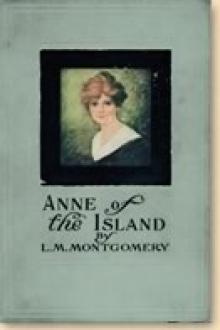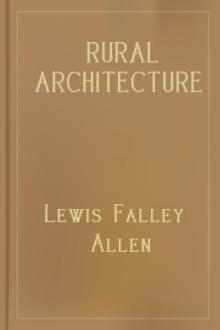A History of Art for Beginners and Students, Clara Erskine Clement Waters [best beach reads .txt] 📗

- Author: Clara Erskine Clement Waters
- Performer: -
Book online «A History of Art for Beginners and Students, Clara Erskine Clement Waters [best beach reads .txt] 📗». Author Clara Erskine Clement Waters
But perhaps it is as an architect that Orcagna is most interesting to us, for he it was who made the designs for the Loggia de Lanzi in Florence. This was built as a place for public assembly, and the discussion of the topics of the day in rainy weather; it received its name on account of its nearness to the German guard-house which was called that of the Landsknechts (in German), or Lanzi, as it was given in Italian. Orcagna probably died before the Loggia was completed, and his brother Bernardo succeeded him as architect of the commune. This Loggia is one of the most interesting places in Florence, fully in sight of the Palazzo Signoria, near the gallery of the Uffizi, and itself the storehouse of precious works of sculpture.
There were also in these early days of the fourteenth century schools of art at Bologna and Modena; but we know so little of them in detail that I shall not attempt to give any account of them here, but will pass to the early artists who may be said to belong to the true Renaissance in Italy.
PAINTING IN ITALY, FROM THE BEGINNING OF THE RENAISSANCE
TO THE PRESENT CENTURY.
The reawakening of Art in Italy which followed the darkness of the Middle Ages, dates from about the beginning of the fifteenth century and is called the Renaissance. The Italians have a method of reckoning the centuries which differs from ours. Thus we call 1800 the first year of the nineteenth century, but they call it the first of the eighteenth; so the painters of what was to us the fifteenth century are called by Italians the “quattrocentisti,” or men of the fourteenth century, and while to us the term “cinquecento” means the style of the sixteenth century, to the Italians the same century, which begins with 1500, is the fifteenth century.
I shall use our own method of reckoning in my writing; but this fact should be known to all who read or study art.
The first painter of whom I shall now speak is known to us as Fra Angelico. His name was Guido, the son of Pietro, and he was born at Vicchio in the province of Mugello, in the year 1387. We know that his family was in such circumstances that the young Guido could have led a life of ease; but he early determined to become a preaching friar. Meantime, even as a boy, he showed his taste for art, and there are six years in his life, from the age of fourteen to twenty, of which no one can tell the story. However, from what followed it is plain that during this time he must somewhere have devoted himself to the study of painting and to preparation for his life as a monk.
Before he was fully twenty years old, he entered the convent at Fiesole, and took the name of Fra, or Brother Giovanni; soon after, his elder brother joined him there, and became Fra Benedetto. Later on our artist was called Fra Angelico, and again Il Beato Angelico, and then, according to Italian custom, the name of the town from which he came was added, so that he was at last called Il Beato Giovanni, detto Angelico, da Fiesole, which means, “The Blessed John, called the Angelic, of Fiesole.” The title Il Beato is usually conferred by the church, but it was given to Fra Angelico by the people, because of his saintly character and works.
It was in 1407 that Fra Angelico was admitted to the convent in Fiesole, and after seven years of peaceful life there he was obliged to flee with his companions to Foligno. It was at the time when three different popes claimed the authority over the Church of Rome, and the city of Florence declared itself in favor of Alexander V.; but the monks of Fiesole adhered to Gregory XII., and for this reason were driven from their convent. Six years they dwelt at Foligno; then the plague broke out in the country about them, and again they fled to Cortona. Pictures painted by Fra Angelico at this time still remain in the churches of Cortona.
After an absence of ten years the monks returned to Fiesole, where our artist passed the next eighteen years. This was the richest period of his life: his energy was untiring, and his zeal both as an artist and as a priest burned with a steady fire. His works were sought for far and wide, and most of his easel-pictures were painted during this time. Fra Angelico would never accept the money which was paid for his work; it was given into the treasury of his convent; neither did he accept any commission without the consent of the prior. Naturally, the monk-artist executed works for the adornment of his own convent. Some of these have been sold and carried to other cities and countries, and those which remain have been too much injured and too much restored to be considered important now.
He painted so many pictures during this second residence at Fiesole, not only for public places, but for private citizens, that Vasari wrote: “This Father painted so many pictures, which are dispersed through the houses of the Florentines, that sometimes I am lost in wonder when I think how works so good and so many could, though in the course of many years, have been brought to perfection by one man alone.”
In 1436 the great Cosimo de Medici insisted that the monks of Fiesole should again leave their convent, and remove to that of San Marco, in Florence. Most unwillingly the brethren submitted, and immediately Cosimo set architects and builders to work to erect a new convent, for the old one was in a ruinous state. The new cloisters offered a noble field to the genius of Fra Angelico, and he labored for their decoration with his whole soul; though the rule of the order was so strict that the pictures in the cells could be seen only by the monks, he put all his skill into them, and labored as devotedly as if the whole world could see and praise them, as indeed has since been done. His pictures in this convent are so numerous that we must not describe them, but will say that the Crucifixion in the chapter-room is usually called his masterpiece. It is nearly twenty-five feet square, and, besides the usual figures in this subject, the Saviour and the thieves, with the executioners, there are holy women, the founders of various orders, the patrons of the convent, and companies of saints. In the frame there are medallions with several saints and a Sibyl, each bearing an inscription from the prophecies relating to Christ’s death; while below all, St. Dominic, the founder of the artist’s order, bears a genealogical tree with many portraits of those who had been eminent among his followers. For this reason this picture has great historic value.
At last, in 1445, Pope Eugenius IV., who had dedicated the new convent of San Marco and seen the works of Angelico, summoned him to Rome. It is said that the Pope not only wished for some of his paintings, but he also desired to honor Angelico by giving him the archbishopric of Florence; but when this high position was offered him, Fra Angelico would not accept of it: he declared himself unequal to its duties, and begged the Pope to appoint Fra Antonino in his stead. This request was granted, and Angelico went on with his work as before, in all humility fulfilling his heaven-born mission to lead men to better lives through the sweet influence of his divine art.
The honor which had been tendered him was great—one which the noblest men were striving for—but if he realized this he did not regret his decision, neither was he made bold or vain by the royal tribute which the Pope had paid him.
From this time the most important works of Fra Angelico were done in the chapel of Pope Nicholas V., in the Vatican, and in the chapel which he decorated in the Cathedral of Orvieto. He worked there one summer, and the work was continued by Luca Signorelli. The remainder of his life was passed so quietly that little can be told of it. It is not even known with certainty whether he ever returned to Florence, and by some strange fate the key to the chapel which he painted in the Vatican was lost during two centuries, and the pictures could only be seen by entering through a window. Thus it would seem that his last years were passed in the quiet work which he best loved.
In the Uffizi, Florence.
By Fra Angelico.
When his final illness was upon him, the brethren of Santa Maria Sopra Minerva, where he resided, gathered about him, and chanted the Salve Regina. He died on the 18th of February, 1455, when sixty-seven years old. His tombstone is in the church of Santa Maria Sopra Minerva, in Rome; on it lies the figure of a Dominican monk in marble. Pope Nicholas V. wrote his epitaph in Latin. The following translation is by Professor Norton:
“Not mine be the praise that I was a second Apelles,
But that I gave all my gains to thine, O Christ!
One work is for the earth, another for heaven.
The city, the Flower of Tuscany, bore me—John.”
In the Convent of San Marco in Florence there are twenty-five pictures by this master; in the Academy of Florence there are about sixty; there are eleven in the chapel of Nicholas V., and still others in the Vatican gallery. The Church of Santa Maria Novella, Florence, the Cathedral of Orvieto, the Church of St. Domenico in Perugia, and that of Cortona, are all rich in his works. Besides these a few exist in some of the principal European galleries; but I love best to see them in San Marco, where he painted them for his brethren, and where they seem most at home.
The chief merit of the pictures of Fra Angelico is the sweet and tender expression of the faces of his angels and saints, or any beings who are holy and good; he never succeeded in painting evil and sin in such a way as to terrify one; his gentle nature did not permit him to represent





Comments (0)